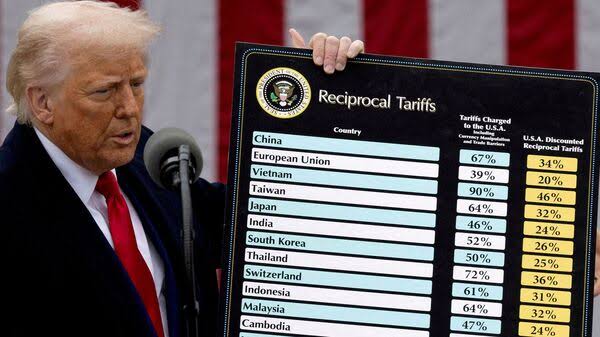
U.S. economy stays strong despite global trade war, but rising tariffs spark inflation and stagflation fears. Image: Mint.
(The Post News) – Donald Trump has taken his fight on trade tariffs to the U.S. Supreme Court, asking the justices to overturn a ruling that deemed most of his sweeping import duties illegal. The move sets up one of the most important legal tests of his presidency, with implications for U.S. businesses, global trade, and the balance of power between Congress and the White House.
The petition, filed late Wednesday, requests review of a 7-4 decision by the U.S. Court of Appeals for the Federal Circuit. The court ruled last week that Trump exceeded his authority as president when he imposed tariffs of 10% to 50% on most U.S. imports in April, which he had declared as “liberation day” border taxes.
The judges clarified that the International Emergency Economic Powers Act (IEEPA) of 1977 does not grant the president blanket authority to assess taxes or tariffs. While the act gives the White House broad powers during national emergencies, the court pointed out that it does not encompass sweeping and open-ended trade taxes.
The tariffs were open-ended in scope, amount, and duration,” the majority opinion wrote, adding that Trump’s actions “claim sweeping authority beyond the law’s express limits.”
Trump pushes for an urgent Supreme Court review.
Trump was quick to retaliate. “If allowed to stand, this ruling would literally destroy the United States of America,” he wrote on his Truth Social platform. On Tuesday, he urged a quick ruling, saying that without tariffs the U.S. “can end up being a third-world country.”
Solicitor General D. John Sauer submitted the administration’s Supreme Court appeal electronically on Wednesday night, urging the justices to move fast. The petition asked the court to decide by September 10 whether to hear the case, with arguments by November and a decision by the end of the year.
That decision casts a shadow of uncertainty over ongoing foreign negotiations the president has been pursuing through tariffs,” Sauer wrote. He argued that without a quick resolution, delicate trade discussions with allies would collapse.
While Trump frames tariffs as a tool to protect American industry, businesses across the U.S. have felt the pinch. Levi’s recently warned that “rising anti-Americanism as a consequence of the Trump tariffs and governmental policies” could hurt its UK sales. Tesla has also faced consumer backlash in Europe and Canada. Even American whiskey brands such as Jack Daniel’s have suffered from boycotts abroad.
Small businesses, which led the legal action against Trump, say the tariffs have left them battling for survival. Jeffrey Schwab, senior attorney at the Liberty Justice Center, said, “These unlawful tariffs are imposing tremendous harm on small businesses and jeopardizing their capacity to endure. We hope our customers rapidly resolve this instance.”
Billions at stake in refunds and trade deals
Economists have estimated that the reversal of the tariffs would cut in half the U.S. average effective tariff rate of 16.3%. It would also force the Treasury to refund tens of billions of dollars that importers have paid. Chris Kennedy at Bloomberg Economics stated that the financial blow could derail early trade deals Trump has negotiated with the UK and EU.
Tariff revenues have doubled under Trump. The U.S. Treasury had collected $159 billion through late August, more than double as much as in the same year-earlier period. Critics argue the costs have been transferred to U.S. manufacturers and consumers, stoking inflation and slowing economic growth.
Underlying the case is a constitutional question: who ultimately gets to decide to impose tariffs? The U.S. Constitution assigns that power to Congress, but lawmakers over the years have relinquished some of it to the executive branch. Trump has pushed that power further than any president in recent history, leaning heavily on IEEPA to justify broad tariffs without congressional approval.
It’s now for the Supreme Court, with its 6-3 conservative majority that features three Trump-appointed justices, to rule whether IEEPA authorizes such sweeping action. The case could be a landmark ruling on the limits of presidential power, legal experts say, similar to the court’s 2023 rejection of President Joe Biden’s student loan forgiveness program under the “major questions doctrine.”
What’s at stake?
The case addresses two important groups of tariffs. The first is Trump’s global “reciprocal” tariffs, ranging from 10% on most imports to 34% on Chinese imports. The second targets Canada, Mexico, and China with 25% tariffs associated with fentanyl concerns. Tariffs on steel, aluminum, and autos, imposed under different legislation, are not directly considered by this ruling.
Even if the Supreme Court rules against Trump, he could try to impose tariffs under other statutes, though those laws limit how quickly and severely he can act.
The tariffs remain in effect at least through October 14 for the time being. But the Supreme Court’s final decision could remake U.S. trade policy and redefine the president’s power to employ tariffs both as a source of revenue and as a bargaining chip in global negotiations.



